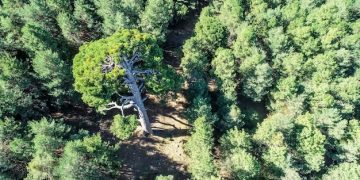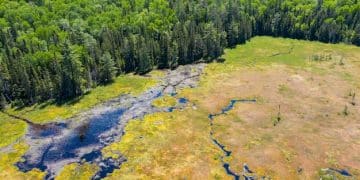US Reforestation: 1 Billion Trees by 2030 – Impact?

The ambitious US government campaign to plant one billion trees by 2030 aims to mitigate environmental damage, but its success hinges on strategic implementation, long-term maintenance, and effective integration with broader climate policies.
The imperative to address climate change and environmental degradation has never been more urgent, prompting governments worldwide to explore innovative solutions. In the United States, a significant initiative is underway: The US Government’s Reforestation Campaign: Can Planting 1 Billion Trees by 2030 Reverse Environmental Damage? This ambitious endeavor seeks to harness the natural power of trees to restore ecological balance, but the question remains whether such a massive undertaking can genuinely counteract decades of environmental strain.
The Vision Behind the Billion Tree Initiative
The US government’s commitment to planting one billion trees by 2030 represents a significant pivot towards nature-based solutions for climate resilience. This ambitious goal stems from a growing recognition of forests’ multifaceted benefits, from carbon sequestration to biodiversity enhancement. The initiative is not merely about numbers; it aims to strategically restore ecosystems that have suffered from historical deforestation, wildfires, and urban expansion.
At its core, this campaign seeks to leverage the biological power of trees to absorb atmospheric carbon dioxide, a primary greenhouse gas. Beyond carbon, the vision encompasses improving air and water quality, preventing soil erosion, and restoring critical habitats for countless species. This holistic approach suggests a move beyond singular environmental fixes towards integrated ecological recovery.
However, the path to achieving this vision is complex. It requires meticulous planning, substantial funding, and sustained public engagement. The success of such a monumental task depends on whether the government can effectively coordinate efforts across various agencies, private landowners, and local communities.
Historical context of reforestation efforts
Reforestation is not a new concept in the US. Historically, programs like the Civilian Conservation Corps (CCC) during the Great Depression planted billions of trees, leaving a lasting legacy on the American landscape. These past initiatives provide valuable lessons, highlighting the importance of resilient species selection, proper planting techniques, and post-planting care. The current campaign builds on this foundation, attempting to scale up efforts to meet contemporary environmental challenges.
Key objectives and targets for 2030
The primary objective is carbon sequestration, but secondary targets are equally vital. These include:
- Enhancing biodiversity by planting native species.
- Improving water retention and reducing runoff in critical watersheds.
- Restoring forest health in fire-prone regions.
- Creating green jobs in forestry and related sectors.
These objectives emphasize the campaign’s broad scope, aiming for ecological, economic, and social benefits. The 2030 deadline adds a sense of urgency, driving rapid implementation across different landscapes.
The initiative represents a hopeful step, but also raises questions about the practicalities of planting, nurturing, and protecting such a vast number of trees to maturity. It’s a race against time, with the climate crisis as the formidable backdrop.
Scientific Basis: How Trees Combat Environmental Damage
The scientific consensus is unequivocal: trees play a vital role in regulating the Earth’s climate and supporting ecosystems. Their ability to sequester carbon, purify air, and manage water cycles makes them indispensable allies in mitigating environmental damage. Understanding these mechanisms is crucial to appreciating the potential impact of a large-scale reforestation campaign.
Trees act as natural carbon sinks, absorbing CO2 through photosynthesis and storing it in their biomass—trunks, branches, leaves, and roots—and in the soil. This process effectively removes greenhouse gases from the atmosphere, helping to slow global warming. Beyond carbon, forests regulate local climates, reducing extreme temperatures and improving humidity, which can be critical in combating heat island effects in urban areas.
Furthermore, healthy forests are integral to the water cycle. They capture rainfall, reduce storm runoff, and filter pollutants as water percolates through the soil, replenishing groundwater supplies. Their root systems stabilize soil, preventing erosion and landslides, especially in vulnerable areas. The ecological benefits extend to supporting a vast array of wildlife, providing crucial habitats and promoting biodiversity.
Carbon sequestration: the primary mechanism
The most frequently cited benefit of reforestation is carbon sequestration. Young, growing trees absorb CO2 rapidly, and mature forests store vast amounts of carbon over decades or centuries. The billion-tree campaign hypothesizes that this massive carbon uptake could help offset a significant portion of US emissions, contributing to national and international climate goals.
Impact on biodiversity and ecosystems
Reforestation, when done correctly with native species, can help restore biodiversity. Monoculture tree farms, while efficient for timber, offer limited ecological benefit. The campaign’s focus on diverse, resilient forests is paramount for creating robust ecosystems that can withstand future environmental pressures. This includes creating corridors for wildlife and restoring food chains disrupted by habitat loss.
Water cycle regulation and soil health
Trees and forests significantly influence the water cycle:
- They increase infiltration rates, reducing surface runoff and flooding.
- Tree canopies intercept rainfall, slowing its descent and reducing erosion.
- Root systems bind soil, enhancing stability and nutrient retention.
These functions are critical for maintaining healthy watersheds and supporting agricultural productivity. Reversing environmental damage isn’t just about carbon; it’s about restoring the fundamental processes that sustain life. The ultimate success of the campaign will depend on selecting the right trees for the right places, ensuring they thrive and fulfill their ecological roles.
Challenges and Complexities of Large-Scale Reforestation
While the aspiration to plant one billion trees is laudable, the practicalities of such a massive undertaking present significant challenges. Reforestation is not simply about putting saplings in the ground; it involves a complex interplay of ecological, logistical, and socio-economic factors. Overlooking these complexities could undermine the campaign’s long-term effectiveness.
One major hurdle is ensuring the long-term survival of newly planted trees. Many saplings succumb to drought, disease, pests, and competition from other vegetation. The choice of species, their genetic diversity, and their suitability to local soil and climate conditions are critical for their resilience and growth. Furthermore, climate change itself, with its increased frequency of extreme weather events like droughts and heatwaves, poses a direct threat to young trees.
Funding is another perpetual challenge. While initial planting costs are substantial, the ongoing maintenance, monitoring, and protection of these vast new forests require continuous investment. Land availability is also a concern, as suitable land for large-scale reforestation might be limited, particularly in densely populated or agriculturally intensive regions. Balancing the needs of reforestation with other land uses is essential.
Survival rates and long-term maintenance
The mortality rate of newly planted trees can be alarmingly high, sometimes exceeding 50% in the first few years. Factors affecting survival include:
- Inadequate initial care and watering.
- Competition from invasive species.
- Lack of protection from grazing animals or human disturbance.
Effective post-planting care, including irrigation in dry periods, pest management, and ongoing monitoring, is crucial for ensuring that these planted trees mature into viable forests.
Climate change impacts on tree growth and health
Ironically, the very phenomenon reforestation aims to combat—climate change—also threatens its success. Changing rainfall patterns, increased temperatures, and more frequent wildfires can stress existing forests and hinder the growth of new ones. Selecting climate-resilient species and implementing adaptive management strategies are vital to protect these investments.
The complexities do not stop there. Engaging local communities and landowners, addressing potential conflicts over land use, and integrating reforestation with broader land management strategies are also critical. Without careful consideration of these challenges, the billion-tree campaign risks falling short of its ambitious goals, resulting in a symbolic gesture rather than a substantive ecological transformation.
Measuring Success: Metrics and Indicators
Determining whether the US government’s reforestation campaign truly reverses environmental damage requires a robust framework for measuring success. It’s not enough to simply count planted trees; the real impact lies in their survival, growth, and contribution to ecological health. Establishing clear metrics and continually monitoring progress are essential to validate the campaign’s effectiveness and adapt strategies as needed.
Success metrics must go beyond mere numbers of trees planted. Key indicators should include tree survival rates, growth rates, and canopy cover development. Furthermore, measuring the actual carbon sequestration capacity of the newly established forests, rather than just estimated potential, is crucial for assessing their climate impact. This often involves periodic biomass measurements and soil carbon analyses.
Beyond carbon, the campaign’s success should also be evaluated on its ecological outcomes. This includes monitoring changes in biodiversity, such as the return of native plant and animal species, improvements in water quality, and reductions in soil erosion. Socio-economic indicators, such as job creation in the forestry sector and improved community resilience, also contribute to a comprehensive assessment of the campaign’s overall benefits.
Beyond mere tree counts: ecological outcomes
Ecological success goes deep. It’s about how the new forests function within the broader ecosystem. This includes:
- Monitoring changes in local hydrology and water tables.
- Assessing the return of specific bird, insect, and mammal populations.
- Tracking changes in soil organic matter and nutrient cycling.
These metrics help confirm that the reforestation is creating healthy, self-sustaining ecosystems, not just rows of trees.
Carbon accounting and climate impact assessment
Accurate carbon accounting is paramount. This involves:
- Establishing baselines of carbon stocks before planting.
- Using remote sensing and ground-based measurements to track biomass accumulation.
- Accounting for potential disturbances like wildfires or disease outbreaks that release stored carbon.
This rigorous approach helps determine the true carbon benefit derived from the reforestation efforts. Without precise data, claims of environmental reversal remain speculative. The journey from planting to tangible environmental benefit is a long one, requiring sustained commitment to monitoring and adapti ve management.
Collaboration and Policy Frameworks
The success of a reforestation campaign of this magnitude hinges on strategic collaboration between governmental agencies, private entities, and local communities, supported by robust policy frameworks. This multi-stakeholder approach ensures that efforts are coordinated, resources are maximized, and the benefits are distributed equitably. A fragmented approach risks inefficiencies and missed opportunities.
Government agencies, such as the US Forest Service, Department of Agriculture, and Environmental Protection Agency, play a pivotal role in providing scientific expertise, managing federal lands, and allocating resources. However, a significant portion of suitable land is privately owned, making collaboration with landowners, farmers, and timber companies indispensable. Incentive programs, technical assistance, and educational outreach are critical for fostering their participation.
Non-governmental organizations (NGOs) and local community groups often possess invaluable local knowledge and volunteer networks, facilitating on-the-ground implementation and long-term stewardship. Policy frameworks, including legislation, funding mechanisms, and regulatory guidelines, provide the necessary structure and incentives to drive the campaign forward and ensure its sustainability.
Role of federal and state agencies, and private landowners
Collaboration extends to several levels:
- Federal Agencies: Provide overarching strategy, funding, and research.
- State Agencies: Implement state-specific programs, often with regional expertise.
- Private Landowners: Are crucial for providing land for planting; their participation needs to be incentivized.
Building trust and ensuring mutual benefits are key to fostering strong partnerships across these diverse groups.
Incentive programs and legislative support
Effective reforestation requires more than just goodwill. It needs actionable policies:
- Tax Incentives: Encourage landowners to dedicate land to reforestation.
- Grants and Subsidies: Support planting and maintenance costs.
- Legislation: Protect newly established forests from future development or unsustainable practices.
An adaptive policy framework can respond to changing environmental conditions and socio-economic needs, ensuring the campaign remains relevant and effective. Without a solid policy backbone and widespread collaboration, the billion-tree initiative could struggle to achieve its full potential in reversing environmental damage. The challenge lies in creating enduring partnerships that transcend political cycles and short-term economic interests.
Future Outlook: Beyond 2030 and Comprehensive Solutions
Looking beyond the immediate goal of planting one billion trees by 2030, the true measure of success for the US government’s reforestation campaign lies in its long-term sustainability and its integration into a broader strategy for environmental repair. Reforestation is a powerful tool, but it is not a silver bullet. Its maximum impact will only be realized when coupled with other aggressive climate and conservation policies.
The future outlook necessitates a shift from merely planting trees to fostering resilient, biodiverse forest ecosystems that can adapt to a changing climate. This involves continuous monitoring, adaptive management practices, and ongoing research into climate-resilient tree species and ecologies. Furthermore, protecting existing mature forests from logging, wildfires, and conversion remains as crucial as planting new ones, as old-growth forests store immense amounts of carbon and biodiversity.
Ultimately, the reforestation campaign can serve as a cornerstone of a comprehensive environmental strategy, but it must be complemented by significant reductions in fossil fuel emissions, investment in renewable energy, and sustainable land-use practices. A holistic approach acknowledges that environmental damage is multifaceted and requires a multi-pronged response.
Integration with broader climate and conservation strategies
Reforestation must be part of a larger ecological puzzle:
- Complementing efforts to reduce industrial and transportation emissions.
- Working in synergy with renewable energy development.
- Supporting conservation of existing wetlands, grasslands, and oceans for their carbon storage and biodiversity benefits.
A disconnected approach risks merely offsetting damage rather than reversing it.
Long-term sustainability and adaptive management
Sustainability is key. This includes:
- Developing long-term funding mechanisms for continuous forest management.
- Implementing adaptive management to respond to climate shifts and new threats.
- Investing in ecological restoration science and technology for ongoing innovation.
The concept of “reversing environmental damage” is an ambitious one, suggesting a return to a healthier, pre-impact ecological state. While the billion-tree campaign is a significant step, achieving this reversal will require an unwavering, decades-long commitment to both nature-based solutions and fundamental changes in how society produces and consumes resources. The 2030 target is a milestone, not the finish line, in the ongoing fight against environmental degradation.
| Key Aspect | Brief Description |
|---|---|
| 🌳 Billion Tree Goal | US aims to plant one billion trees by 2030 to combat climate change. |
| 🔬 Scientific Impact | Trees sequester carbon, enhance biodiversity, and regulate water cycles. |
| 🚧 Core Challenges | Ensuring seedling survival, ongoing maintenance, and climate change impacts are key hurdles. |
| 🤝 Collaborative Effort | Success relies on government, private landowners, and community partnerships. |
Frequently Asked Questions About US Reforestation
The US government’s reforestation campaign is an ambitious initiative aiming to plant one billion trees by 2030 across federal, state, and private lands. It’s part of a broader strategy to combat climate change, enhance biodiversity, and restore ecological health through nature-based solutions.
Trees absorb carbon dioxide, a major greenhouse gas, mitigating climate change. They also improve air and water quality, prevent soil erosion, enhance biodiversity by providing habitats, and regulate local climates, all contributing to reversing various forms of environmental degradation.
Significant challenges include ensuring the high survival rate of newly planted trees, securing long-term funding for maintenance, addressing land availability issues, and adapting to climate change impacts like droughts and wildfires that threaten young forests and existing ones. Community engagement is also crucial for success.
Success will be measured beyond just tree counts. Key indicators include tree survival and growth rates, actual carbon sequestration, improvements in biodiversity and water quality, and reductions in soil erosion. Rigorous monitoring and scientific assessments are essential to verify its ecological impact.
No, reforestation is a powerful tool but not a standalone solution. While vital for carbon removal and ecosystem restoration, it must be integrated with aggressive efforts to reduce fossil fuel emissions, transition to renewable energy, and implement sustainable land-use practices for a comprehensive approach to climate change and environmental reversal.
Conclusion
The US government’s ambitious campaign to plant one billion trees by 2030 represents a significant commitment to leveraging nature-based solutions in the fight against environmental degradation and climate change. While the scientific basis for reforestation’s benefits—from carbon sequestration to biodiversity enhancement—is clear, the path to achieving a true reversal of environmental damage is fraught with complexities. Success hinges not just on planting numbers, but on ensuring the long-term survival and ecological health of these new forests, navigating challenges posed by climate change itself, and fostering robust collaboration across all sectors. Ultimately, this initiative is a vital component of a holistic environmental strategy, but it must be complemented by deep emissions cuts and sustainable practices to forge a truly resilient and healthy future for the planet.





